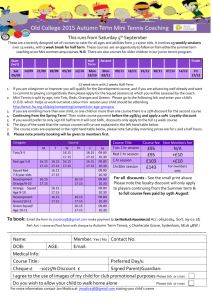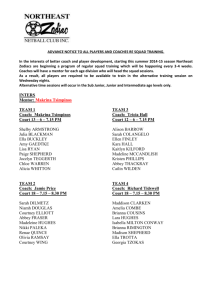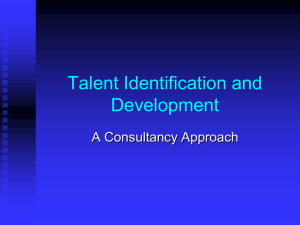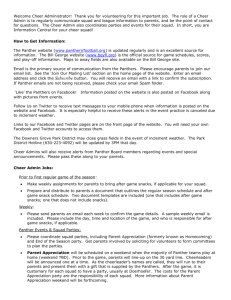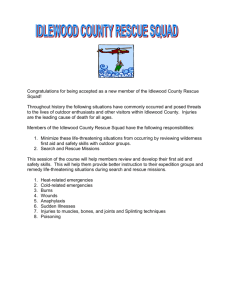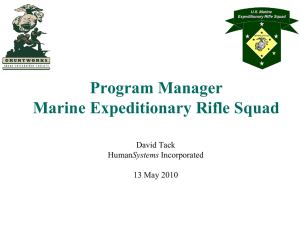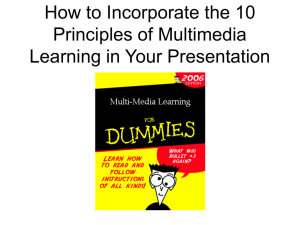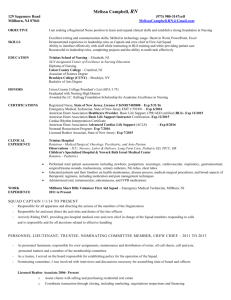Cadet Name: Date: 1. (U2C6L4:F1) What process does this graphic
advertisement
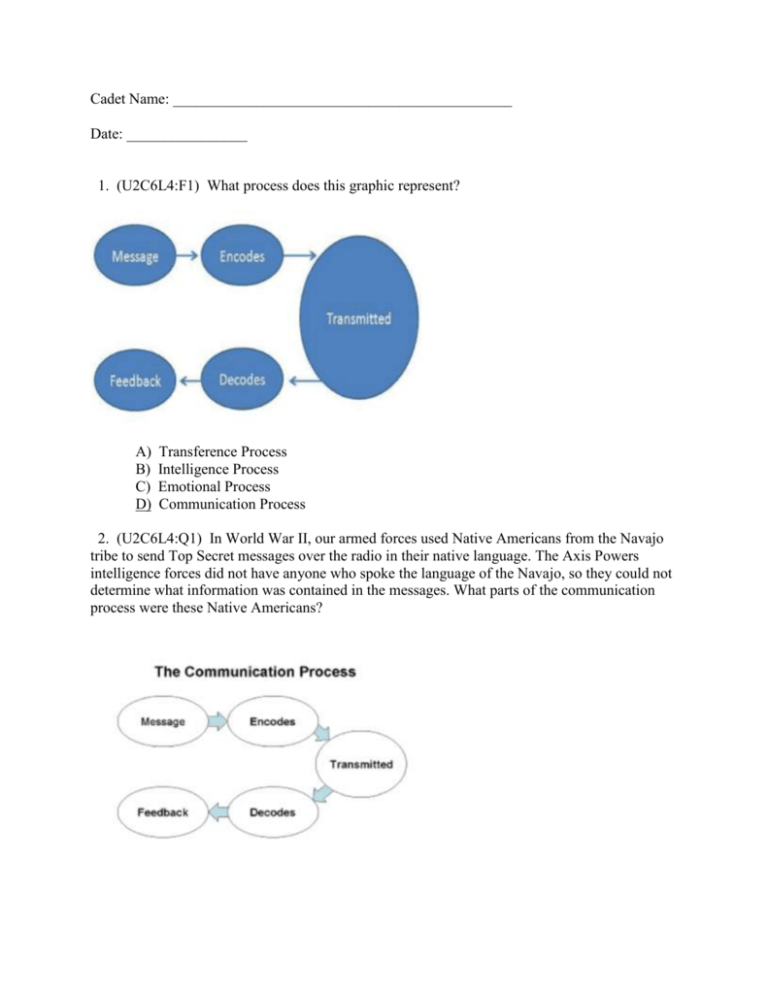
Cadet Name: _____________________________________________ Date: ________________ 1. (U2C6L4:F1) What process does this graphic represent? A) B) C) D) Transference Process Intelligence Process Emotional Process Communication Process 2. (U2C6L4:Q1) In World War II, our armed forces used Native Americans from the Navajo tribe to send Top Secret messages over the radio in their native language. The Axis Powers intelligence forces did not have anyone who spoke the language of the Navajo, so they could not determine what information was contained in the messages. What parts of the communication process were these Native Americans? A) B) C) D) Encodes and Decodes Encodes and Transmit Message and Feedback Decodes and Feedback 3. (U2C6L4:Q2) When a radio message ends with, "Wilco, Out" it means "I have received your message and will comply; this is the end of the message and you don't have to reply." What part of the communication process is "Wilco, Out" A) B) C) D) Message Encode Decode Feedback 4. (U2C6L4:Q3) George was standing in line at the Toy Store after buying his niece a birthday present. A real pushy person cut in to the front of the line. Though he could feel his anger growing, George took a deep breath; then he told himself that he wasn't in a hurry, and if an adult cuts in line, then that person probably has some serious maturity issues. He didn't say anything. Which emotion management skill is George applying? A) B) C) D) Empathy Self-awareness Self-motivation Self-regulation 5. (U2C6L4:G1) T or F: Feedback to subordinates is most effective when it is immediate. A) True B) False 6. (U2C6L4:G2) ___________ is defined as the transference of understanding of a meaning. A) B) C) D) Listening Communication Talking Debate 7. (U2C5L5:F1) Which of the following is not a stationary movement? A) B) C) D) Attention Route Step Facing Movements Saluting 8. (U2C5L5:Q1) You are a squad leader. You are drilling your squad in movements that begin with the right foot from the halt position. Which one do you NOT want to call? A) B) C) D) About, face Close interval, march Column right, march Right step, march 9. (U2C5L5:Q4) You misunderstood your platoon sergeant's instructions to form in a column formation. You are now in a line formation. If direction was unimportant, which of the following commands would be the easiest, quickest way to change a line formation to a column formation? A) B) C) D) "Fall out. In a column formation, fall in" "Column right, march" "Right, face" "Right turn, march" 10. (U2C5L5:F2) Executing a predefined set of movements is known as what? A) Formation B) Drills C) Marching D) Movement 11. (U2C5L5:V3) What is the definition of the term "stationary movements"? A) visual evaluation B) drill movements executed while remaining in place C) groups of people aligned in a specific pattern D) executing a pre-defined set of movements 12. (U2C5L5:V5) What is the definition of the word "inspection"? A) B) C) D) visual evaluation drill movements executed while remaining in place groups of people aligned in a specific pattern executing a pre-defined set of movements 13. (U2C5L2:F1) What are the main factors that will determine the morale of your team members and the degree they are willing to work as a team to accomplish your goals? A) B) C) D) your reputation and planning skills your appearance and intelligence your actions and behavior your age and actions 14. (U2C5L2:Q2) Leaders at all levels are expected to "Set the example" for their subordinates. Which part of leadership best demonstrates this behavior? A) B) C) D) Coach Counselor Role Model Teacher 15. (U2C5L2:Q3) Cadet Meyer was assigned as a squad leader. He knew the squad had some discipline problems before he became squad leader, so he developed a plan before he became squad leader and immediately put it into action. Of the four steps leaders use to ensure a smooth and successful beginning, which one is he executing as he watches how his new squad reacts? A) B) C) D) Observe/Assess Plan Implement Follow-up/Evaluate 16. (U2C5L2:Q4) You just got promoted to squad leader for a squad in another platoon. It was a surprise because the previous squad leader got demoted that morning for poor performance. You don't know any of your new squad members. What's the first thing you should do as you take over the squad? A) B) C) D) Make a plan. Observe the squad's performance. Find out why the previous squad leader got demoted. Evaluate the previous squad leader's plan before you implement yours. 17. (U2C5L2:V1) Choose the synonym for the word below. implement A) B) C) D) cancel fulfill hinder delay 18. (U2C5L2:V3) Choose the synonym for the word below. plan A) B) C) D) inaction rest idleness action 19. (U2C4L2:G1) Define "active listening." A) Having good hygiene to remove ear-wax buildup so that you are better able to listen to others when they speak. B) Interrupting other speakers to show your engagement in a topic of discussion. C) Listening with your eyes and ears and focusing completely on the communicator's eyes, facial expressions, and gestures. D) Listening closely while you are walking or moving. 20. (U2C4L2:G2) What are the five techniques that help improve listening skills? A) Sitting up straight, breathing deeply, leaning forward, nodding, and interrupting. B) Crossing your arms, looking at the floor, saying nothing, asking nothing, yawning, and being patient. C) Maintain an open body position, maintain eye contact, repeat back and clarify what has been said, check out the meaning of what you have heard, and ask many questions. D) Respecting others, maintaining equality, inventing confidences, sharing stories about yourself, and speaking softly. 21. (U2C4L2:G5) Leaders who are faithful to the Constitution, the Army, and the organization and who work within the system without manipulating it for personal gain exhibit the value of ______________. A) B) C) D) Loyalty Duty Responsibility Honor 22. (U2C4L2:G6) Leaders who fulfill obligations and carry out mission requirements exhibit the value of ___________. A) B) C) D) Honor Duty Integrity Loyalty 23. (U2C4L2:G8) Leaders who put the welfare of their subordinates before their own and share subordinates' hardships demonstrate the value of ______________. A) B) C) D) Integrity Valor Hardiness Selfless Service 24. (U2C4L2:G12) Leaders who readily interact with others to coach, teach, counsel, motivate, and empower others are demonstrating _______________ skills. A) B) C) D) Communication Interpersonal Negotiating Personal Courage 25. (U2C3L2:Q2) Every three months, Cadet Pearson met his goal of improving his 2-mile run time. Cadet Stevens said, "Why don't you just set one goal of your absolute best possible time and try to reach it, instead of having to change your goal every quarter?" What should Cadet Pearson say to help Cadet Stevens better understand goal-setting? A) "Because each time I improve, I accomplish a goal and can re-evaluate and then reset another goal." B) "Because I wouldn't ever reach that goal." C) "Because it would take me three years to reach that goal." D) "That's a good idea. I'll do it." 26. (U2C3L2:Q3) Brian is a squad leader. He set a physical fitness goal for the squad to average 80% on the physical fitness test. He made a step-by-step plan to prepare the squad, and will check off each step as they perform it. What did Brian most likely NOT think of while he was making his plan? A) B) C) D) That it may have too many steps That the goal is unattainable That the plan lacks a motivation element That there isn't a way to monitor progress 27. (U2C3L2:Q4) While always considering the capabilities of your squad, you use the same strategy to develop squad goals. What is the correct order of that strategy? A) Establish conditions, identify the tasks, prioritize, and write them down. B) Identify the tasks, prioritize, establish conditions, and write them down. C) Prioritize, establish conditions, identify the tasks, and write them down. 28. (U2C2L6:Q1) You are a squad leader. When your squad is formed as part of a larger formation, where should your position be? A) B) C) D) Three steps in front of and centered on the squad. The right flank, or number one (base) position, of the squad. Three steps to the left and centered on the squad. The left flank, or number one (base) position, of the squad. 29. (U2C2L6:Q2) You are the first squad leader. When your platoon sergeant forms the platoon in a line, your squad is in front of the rest of the platoon. If your platoon is middle platoon of three platoons, which of the following actions should you take upon forming? A) Look to the right and align yourself with the platoon to the right as you lift your left arm. B) Look straight ahead as you lift your left arm. C) Look to the left to make sure your squad is aligned correctly. D) Stand three steps to the left and center of your squad. 30. (U2C2L6:V1) What is the definition of the word "line"? A) to form up in column B) to form up in files, facing forward the width of the formation C) to form up line abreast D) to form up in ranks, facing forward the length of formation 31. (U2C2L6:V5) What is the definition of the term "double interval"? A) B) C) D) two arms' distance between troops in rank formation elbow's distance between troops in rank formation to form up in ranks, facing forward the length of formation single arm's distance between troops in rank 32. (U2C2L6:V3) What is the definition of the word "column"? A) B) C) D) to form up line abreast to form up in ranks, facing forward the length of formation the side of the formation, either left or right to form up in files, facing forward the width of the formation 33. (U2C2L6:V7) What is the definition of the term "close interval"? A) B) C) D) two arms' distance between troops in rank formation single arm's distance between troops in rank elbow's distance between troops in rank formation to turn in position 34. (U2C2L6:V8) What is the definition of the word "formation"? A) B) C) D) patterned arrangement of troops a command for marching in place to form up line abreast to turn in position 35. (U2C2L6:V9) What is the definition of the term "normal interval"? A) B) C) D) patterned arrangement of troops single arm's distance between troops in rank elbow's distance between troops in rank formation two arms' distance between troops in rank formation 36. (U2C2L6:M1) Match command to squad drill: "Normal interval, march" A) B) C) D) E) F) changing direction changing intervals counting off dismissing the squad forming the squad marching to the flank G) obtaining normal interval H) resting the squad 37. (U2C2L6:M2) Match command to squad drill: "Dress right, dress" A) B) C) D) E) F) G) H) changing direction changing intervals counting off dismissing the squad forming the squad marching to the flank obtaining normal interval resting the squad 38. (U2C2L6:M3) Match command to squad drill: "Column right (left), march" A) B) C) D) E) F) G) H) changing direction changing intervals counting off dismissing the squad forming the squad marching to the flank obtaining normal interval resting the squad 39. (U2C2L5:F3) When at a halt, start all marching movements from the position of attention. A) True B) False 40. (U2C2L5:F2) To march with a 15-inch step from the halt, the command is "_____, _____." A) B) C) D) half step, halt forward, march half step, march double time, march 41. (U2C2L5:Q3) When you are instructing new Cadets on drill commands, inn what order should you explain the five-step marching process? A) Preparatory command step; Command of execution step; Additional step; Intermediate step; Execution of movement. B) Preparatory command step; Additional step; Command of execution step; Intermediate step; Execution of movement. C) Preparatory command step; Intermediate step; Command of execution step; Additional step; Execution of movement. D) Preparatory command step; Intermediate step; Execution of movement; Additional step; Command of execution step. 42. (U2C2L5:Q4) A new cadet in your squad asks you the following question: "From the halt (position of attention), which steps begin by moving the right foot?" Which of the following is most correct? A) B) C) D) "Right, face," "Right step, march," and "Rear, march." "Close interval, march," "Right step, march," and "About, face." "About, face," "Left step, march," and "Route step, march." "Half step, march," "Right step, march," and "Double time, march." 43. (U2C2L5:V4) Choose the word that best matches the definition below. "Standard marching pace of 120 steps per minute." A) B) C) D) E) double time halt quick time rest steps 44. (U2C2L4:V3) Choose the word that best matches the definition below. "Command to relax the body while remaining silent in place and not assuming any particular position." A) B) C) D) Attention At Ease Parade Rest Rest 45. (U2C2L4:V5) Choose the word that best matches the definition below. "A position where you remain standing with your right foot in place; in certain situations, you may move or talk in this position unless otherwise directed." A) Salute B) Rest C) At Ease D) Attention 46. (U2C2L3:Q2) Read the following paragraph, then select the answer that would make the paragraph most correct. The recommended steps for instructing drill are: 1) Explain and demonstrate each new drill movement; 2) have your team members practice it; 3) have your team members execute it; 4) observe each team member to make sure they execute it correctly; 5) provide individual instruction to those who need it; and 6) use appropriate discipline to correct mistakes. A) B) C) D) Change step 5) to read: "make on-the-spot corrections as necessary" Insert "make on-the-spot corrections as necessary" after step 4) and before step 5) Exchange steps 5) and 6) Remove step 6) 47. (U3C10L1:Q2) Stacy is using the FINDS decision process to decide on what to do this summer. She identified three possible choices: Get a job; Volunteer at summer camp; Go to summer school. What should she do next? A) B) C) D) Decide which is the best choice and then act on it. Scrutinize her decision. Name the pros and cons of each. Start setting short-term goals. 48. (U3C10L1:G1) Explain the FINDS Decision-Making Model. A) Fast; Independent; Natural; Determined; Study the decision. B) Figure out the problem; Investigate; Name a leader; Decide on a solution; Study the results. C) Figure out the problem; Identify solutions; Name pros and cons of each choice; Decide which is the best solution and then act on it; Scrutinize the decision. D) Find a project; Identify the benefits; Name the disadvantages; Decide if it's a worthy project; Scrutinize the decision-making process. 49. (U3C10L1:V1) Criteria Filter A) B) C) D) 50. (U3C10L1:V3) Intuition A) B) C) D) 51. (U4C2L7:F2) Why should you stay away from salt if you are going to be involved in some type of activity in the heat? A) B) C) D) Too much salt makes you thirsty. Salt is not a natural product and is therefore bad for you. Increased salt intake decreases your blood pressure. Digesting salt pulls water away from your muscles. 52. (U4C2L7:F4) Which of the following is incorrect for treatment of heat cramps? A) Get the victim to a cooler location. B) Loosen the victim's clothing C) Give a full glass of cool water every 5 minutes D) Discontinue liquids, if victim is nauseated. 53. (U4C2L7:F5) Which of the following is a life-threatening emergency created as a result of the body's inability to regulate its core temperature? A) B) C) D) Heat fatigue Heat stroke Heat cramps Heat exhaustion 54. (U4C2L7:Q2) Read the following passage and select which type of treatment it describes. "Move the victim to a cool, shady area; loosen the victim's clothing; pour water on or apply a cool wet cloth to the victim's skin; if possible, fan the victim; have the victim slowly drink one quart of water; elevate the victim's legs; monitor the victim until symptoms are gone, and seek medical aid if they continue; keep the victim from strenuous activities for the rest of the day." A) B) C) D) Treatment for heat fatigue Treatment for heat exhaustion Treatment for heatstroke Treatment for heat cramps 55. (U4C2L7:Q4) Read the paragraph below, and decide which option (A-D) is correct. Jesse knew he was going to be working outside in hot, humid weather the next day, so he started preparing himself in order to avoid heat injuries. He drank one quart of water an hour, and he put a large amount of salt in his food to replace the water and salt he would lose. He chose loose clothing made out of natural fibers that would cover most of his skin. Since he was going to wear some heavy protective clothing, he planned his hardest work in the cooler hours of early morning and late afternoon. Of all of his actions, which one is most likely to cause a heat injury? A) B) C) D) Drinking only one quart of water each hour Adding a large amount of salt to his food Wearing loose clothing made of natural fibers Planning his hardest work too early or too late 56. (U4C2L7:G2) Another name for the sweat evaporation that carries heat away from the body is ______________. A) self-regulation B) perspiration or perspiring C) condensation D) evaporation 57. (U4C2L7:G3) ______________ is the condition that results when fluids are lost from the body and not replaced. A) B) C) D) Concentration Evaporation Starvation Dehydration 58. (U4C2L7:G6) What physiological event takes place during heat exhaustion? A) The body goes into shock because of retention of too much liquid. B) When the body loses a great amount of fluid through heavy perspiration, less blood flows to vital organs, resulting in a form of shock. C) The body goes into shock because of high humidity and low ventilation. D) The pain of heat cramps is so severe that a form of shock sets in. 59. (U4C2L7:V3) True or False. Ventilation is the circulation of air as a system or means of providing fresh air. A) True B) False 60. (U4C2L8:F3) While out snowboarding you see that your friend is trembling. When you stop to ask if he is okay he complains he is dizzy and you notice his speech is slurred. He is exhibiting signs of __________. A) B) C) D) frostbite trench foot hypothermia snow blindness 61. (U4C2L8:F4) True or False. Massaging the affected area of a cold weather injury is the proper treatment necessary to stimulate blood flow and bring warmth to the area. A) True B) False 62. (U4C2L8:F5) Warming the affected area of a cold weather injury is part of the treatment for all answer choices except __________. A) B) C) D) frostbite immersion foot hypothermia snow blindness 63. (U4C2L8:Q3) Even though the temperature is 53˚F, the light rain and wind put an extra chill in the air. You and three of your friends have been playing touch football for the past three hours, and you just decided to take a break before starting your last game. After a few minutes, your friend Ethan is shivering, and he looks a little pale. He groans as he stands up, and then he trips over his own feet. When you help him up, his hand feels very cold. What should you and your friends do next? A) B) C) D) Start treating him for hypothermia. Start treating him for trench foot or immersion foot. Start treating him for dehydration. Continue to monitor his temperature to see if he warms up. 64. (U4C2L8:G1) What causes trench foot? A) B) C) D) Ingrown toenails Poor foot care in geographic areas that are hot and dry A fungal infection similar to athlete's foot Prolonged exposure of the feet to wet conditions 65. (U4C2L8:G3) T or F: One treatment for frostbite is to put the affected area close to a high heat source such as a fire. A) True B) False 66. (U4C2L8:G5) What do experts mean when they say that precipitation increases cold weather injuries? A) The lower the chance of precipitation, the greater the chance of injuries B) Water, rain, or snow decreases the chance of a cold-weather injury C) Snow indicates severe cold that can cause frostbite D) Water or moisture in the form of rain or snow speeds the loss of body heat and can cause cold injuries 67. (U4C2L8:G7) When ice crystals form in body tissue exposed to temperatures below freezing, it is called ____________. A) B) C) D) goosebumps chill factor frostbite overexposure 68. (U4C2L8:G8) T or F: Subcutaneous frostbite may cause gangrene and lead to the need for surgical removal of the affected part. A) True B) False 69. (U4C2L8:G11) Name the three steps for treating snow blindness. A) Leave the eyes uncovered, apply ointment, and seek medical treatment. B) Cover the eyes with a dark cloth to discourage painful eye movement; Give the eyes complete rest or use dark bandages and glasses to protect the eyes; Seek medical treatment. C) Flush with water, cover in a dark cloth, and seek medical treatment. D) Give the eyes complete rest, flush with water, and apply ointment. 70. (U4C2L8:V2) Insulate A) B) C) D) E) F) G) An injury caused to the body tissue by frost or extreme cold A condition that results when fluids are lost from the body and not replaced Too little body heat with abnormally low internal body temperatures Any form of water, such as rain, snow, sleet, or hail that falls to the earth’s surface To use materials to protect or isolate something from the elements of weather Injuries that are not very serious and only affect the surface of the body Beneath the top layer of skin 71. (U4C2L8:V5) Superficial A) B) C) D) E) F) G) An injury caused to the body tissue by frost or extreme cold A condition that results when fluids are lost from the body and not replaced Too little body heat with abnormally low internal body temperature Any form of water, such as rain, snow, sleet, or hail that falls to the earth’s surface To use materials to protect or isolate something from the elements of weather Injuries that are not very serious and only affect the surface of the body Beneath the top layer of skin Mid Term Exam [Answer Key] 1. D 2. A 3. D 4. D 5. A 6. B 7. B 8. C 9. C 10. B 11. B 12. A 13. C 14. C 15. D 16. B 17. B 18. D 19. C 20. C 21. A 22. B 23. D 24. B 25. A 26. C 27. B 28. B 29. A 30. D 31. A 32. D 33. C 34. A 35. B 36. B 37. G 38. A 39. A 40. C 41. C 42. B 43. C 44. B 45. B 46. B 47. C 48. C 49. B 50. C 51. D 52. C 53. B 54. B 55. B 56. B 57. D 58. B 59. A 60. C 61. B 62. D 63. A 64. D 65. B 66. D 67. C 68. A 69. B 70. E 71. F
